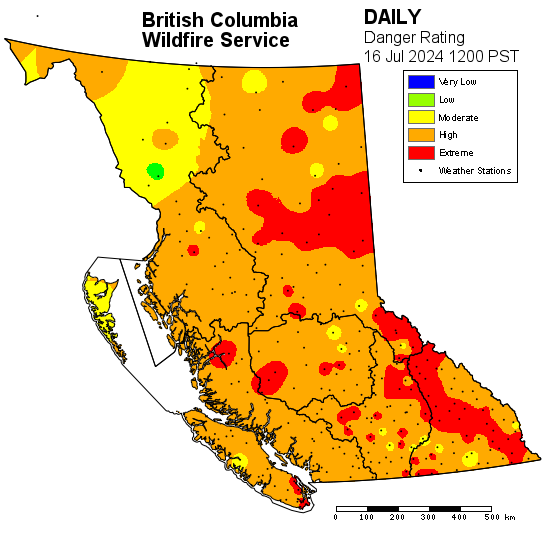There are growing concerns about fire risk as B.C. hits the midpoint in what is increasingly looking like a rain-free July.
“Little to none in the last few weeks,” said Environment Canada meteorologist Chris Doyle, “And not much to look forward to either.”
Doyle said the last measurable precipitation on the South Coast was July 1, and that the prospect of a no-rain month wasn’t out of the question at least for the Lower Mainland.
The situation in the Southern Interior and Southeast looks a little more unstable, but any rain that falls will likely be accompanied by thunderstorms, he said.
“We may want the showers but we don’t want the lightning part, so it’s really a mixed blessing,” he said.
“That’s the kind of spark we don’t need.”

As of Tuesday, virtually all of British Columbia was under a fire danger rating of “High” or “Extreme.”
Environment Canada issued new heat warnings on Tuesday for Howe Sound and Whistler in the southwest of the province, bringing the total to more than 20 across B.C. stretching deep into the Interior and up to Terrace in the north.
Heat warnings continue for the Fraser Canyon, Okanagan Valley, Williams Lake, Kootenay Lake, Cranbrook and elsewhere.
The weather office says daytime highs in the mid to high 30s are expected in the Fraser Canyon and Okanagan, while temperatures in the 30s are expected in parts of the southwest.

The conditions have firefighters on edge, but Assistant Surrey Fire Chief Darren Major said their biggest concern has to do with how people behave.
“Leaves aren’t going to spontaneously combust,” he said.
“It would be mostly human behaviours. We do see little brush fires .. in medians for example, discarded cigarettes from cars, people with campfires, it could be embers.”
Major urged people to be aware of the current risk level and to take extra precautions with any ignition source, including smoking materials and cooking equipment.
Campfires, he added, are banned provincewide.
There were 150 wildfires active in the province on Tuesday, with most activity clustered in the Northeast and Central Interior.
Of those fires, more than half are considered under control, while 37 per cent are out of control and 10 per cent are being held.
— With files from Janet Brown
More on BC
© 2024 Global News, a division of Corus Entertainment Inc.


